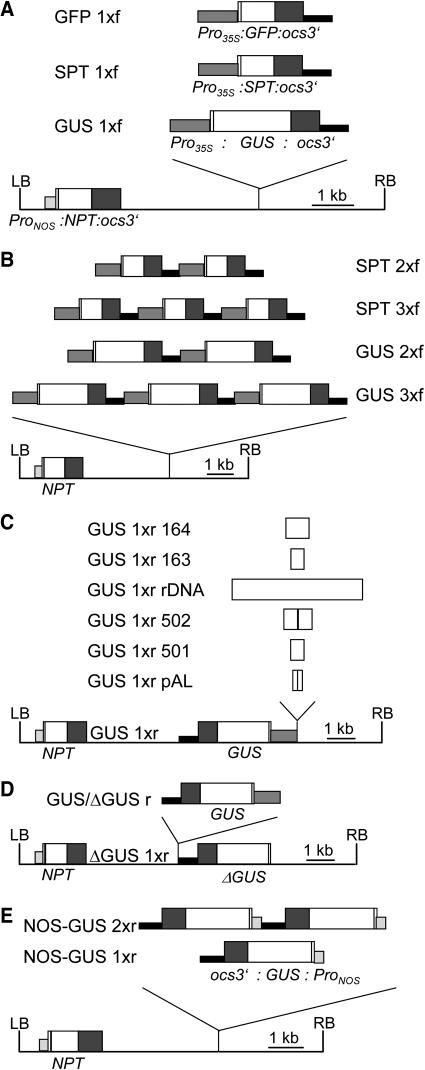Figure 1.
T-DNA Maps.
(A) T-DNAs carrying one copy of a particular chimeric reporter gene cassette. The different T-DNAs were derivatives of vector pMDL-T-DNA that harbored a chimeric NPT gene under the control of ProNOS near the left border (LB). HindIII fragments corresponding to GFP, SPT, and GUS reporter gene cassettes were inserted in both orientations into the HindIII site of vector pMDL-T-DNA to generate constructs GFP 1x, SPT 1x, and GUS 1x. The maps of the f-constructs in which the transcription of the reporter gene was pointing toward the right border are shown. The reporter gene cassettes consisted of the CaMV 35S promoter (Pro35S), a modified Tobacco mosaic virus Ω-leader (shown as a white horizontal bar), the coding sequences of a reporter gene, ocs3′, and Tn5 sequences (depicted as a black vertical bar).
(B) T-DNAs carrying reporter genes in a tandem arrangement. The maps of the f-constructs in which the direction of transcription of the reporter genes was the same as that of the NPT gene are given.
(C) T-DNAs carrying repetitive elements from Arabidopsis upstream of the GUS reporter gene. Construct GUS 1xr pAL contained two copies of the 180-bp HindIII tandem repeat (Martinez-Zapater et al., 1986). GUS 1xr 501 and GUS 1xr 502 carried one and two copies, respectively, of the 500-bp HindIII tandem repeat (Simoens et al., 1988). A fragment corresponding to the intergenic spacer of rDNA sequences (Wanzenböck et al., 1997) was present in T-DNA vector GUS 1xr rDNA. In constructs GUS 1xr 163 and GUS 1xr 164, the sequences cloned upstream of the CaMV 35S promoter corresponded to different dispersed repetitive sequences (Thompson et al., 1996).
(D) T-DNAs carrying a promoterless copy of the GUS gene (ΔGUS). In T-DNA GUS/ΔGUS r, a promoterless copy of the GUS gene adjoined a GUS gene under the control of the CaMV 35S promoter.
(E) T-DNAs carrying the GUS gene under the control of ProNOS.

